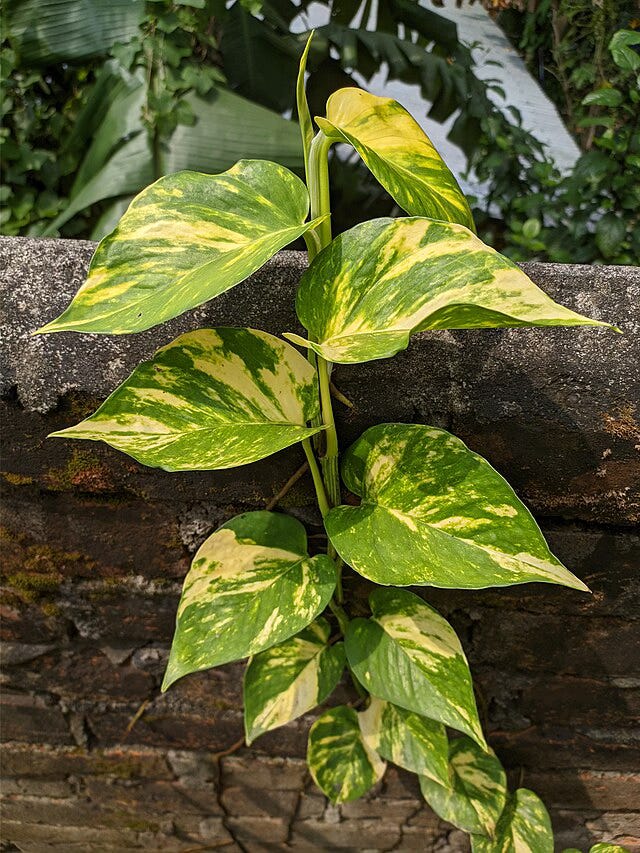Commonly known as golden pothos (not a pothos), Epipremnum aureum is such a ubiquitous member of the houseplant trade, and has been for so many years, that botanists actually had some trouble tracing it back to its native home. But eventually they discovered that it originally came from Mo'orea in the Society Islands of French Polynesia. Nowdays the plant is naturalized all over the world and is considered invasive in many places.
These fast growing and easy to care for vines can easily take over your home as well, growing long trailing tendrils that plant owners can be loath to cut.


This tendency toward abundant growth lends the golden pothos two of its more common names, the money plant, and Devil’s ivy. With its gold-flecked leaves and fecund growth, it’s easy to see why it’s called a money plant, but Devil’s ivy might be a little less obvious. Unfortunately I couldn’t find any solid folklore behind the moniker. One site stated a legend that the demon, The Lord of Flies (aka Beelzebub), cursed the plant in the 1600s, but I couldn’t find this story anywhere else. Most sources pointed to the plant’s almost supernatural ability to thrive despite often being grown in low light and under neglectful conditions.
What is really incredible about Epipremnum aureum is that the form you keep in your home is the plant’s juvenile stage. Out in the wild they get huge, growing up to sixty-six feet in height with leaves as long a forty inches.




Indoors it’s highly unlikely your Epipremnum will ever get as big as a wild specimen, but knowing that it has that kind of potential is pretty cool.
As with most houseplants, the golden pothos won’t flower indoors, but what’s unusual about it is that it rarely flowers in the wild either. Described as a “shy flowering plant”, scientists have discovered that Epipremnum aureum has a genetic gibberellin deficiency. Gibberellin is a hormone responsible for growth, but also for flower, seed, and fruit development. When it does flower, or when flowering is artificially induced, it has an inflorescence typical of plants in the arum family with a spadix protected by a shield-like spathe.
Due to its prevalence around the world the golden pothos has been studied extensively and has a long list of potential uses in medicine. For example, it has been shown to have potential fighting both breast and liver cancer. Its leaves have antibacterial, anti-fungal, antioxidant, anti-diabetic, wound healing, and even anticorrosive properties (the study specifically states low-carbon steel). Even more, its stems have been shown to have gastroprotective abilities. And termites, termites hate it, do with that what you will. As I usually do, I’ll caution you not to go around eating this one. As with most plants in the Arum family it’s packed with calcium oxalates, little crystals that’ll tear you up and leave you with a swollen mouth. I wrote more about them in my Zamioculcus zamiifolia post.
There are quite a few varieties of Epipremnum aureum available on the plant market. I’ve got a Marble Queen and an Njoy. You can let them grow long, keep them trimmed, or let them climb a moss pole, whatever suits your space. Cut stems can be planted in dirt or can be rooted in water. I usually give the stems away when I trim them.



So that’s it! This month’s plant will serve as inspiration for the paid posts in my 100% Plant-Based Horror sections. Here’s the breakdown, in case you’re new and/or curious. And don’t forget, subscriptions are only $2.50/month because everything is expensive and we’re all broke.
First week of the month - The Lab (that’s this post!) - Free for everyone
Second week of the month - The Witch Lab (a short, spooky piece from a plant witch’s journal detailing one of her experiences helping (I use the term loosely) a client using the featured plant of the month - Paid subscribers only, here’s a freebie you can read to check it out!
Third week of the month - The Spell Book (an entry from The Witch’s spell book detailing how she uses this plant for her dark magic including spells, chants, recipes, instructions, and more). Paid subscribers only, here’s a freebie you can read to check it out!
Fourth week of the month - 100% Plant-Based Horror story featuring the month’s plant. These are longer stories that include everything from ghosts, to parasites, aliens, experimental supplements, and more! - Paid subscribers only, here’s a freebie you can read to check it out!






a classic! love to see it getting the love